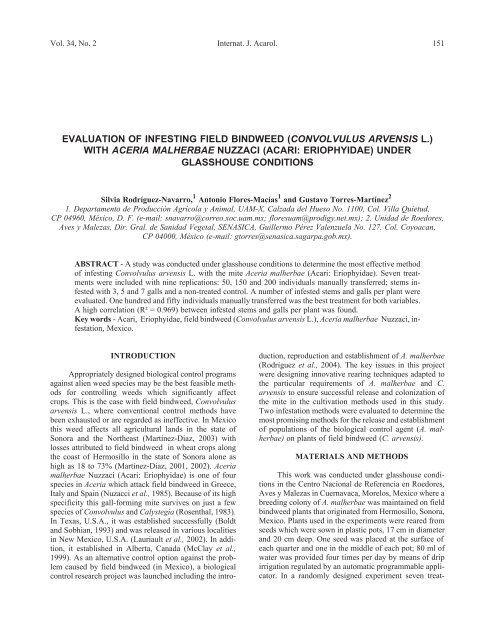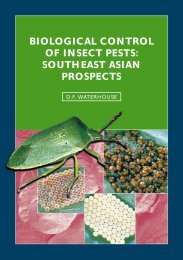You also want an ePaper? Increase the reach of your titles
YUMPU automatically turns print PDFs into web optimized ePapers that Google loves.
Vol. 34, No. 2 Internat. J. Acarol. 151<br />
EVALUATION OF INFESTING FIELD BINDWEED (CONVOLVULUS ARVENSIS L.)<br />
WITH ACERIA MALHERBAE NUZZACI (ACARI: ERIOPHYIDAE) UNDER<br />
GLASSHOUSE CONDITIONS<br />
Silvia Rodríguez-Navarro, 1 Antonio Flores-Macías 1 and Gustavo Torres-Martínez 2<br />
1. Departamento de Producción Agrícola y Animal, UAM-X, Calzada del Hueso No. 1100, Col. Villa Quietud,<br />
CP 04960, México, D. F. (e-mail: snavarro@correo.xoc.uam.mx; floresuam@prodigy.net.mx); 2. Unidad de Roedores,<br />
Aves y Malezas, Dir. Gral. de Sanidad Vegetal, SENASICA, Guillermo Pérez Valenzuela No. 127. Col. Coyoacan,<br />
CP 04000, México (e-mail: gtorres@senasica.sagarpa.gob.mx).<br />
ABSTRACT - A study was conducted under glasshouse conditions to determine the most effective method<br />
of infesting Convolvulus arvensis L. with the mite Aceria malherbae (Acari: Eriophyidae). Seven treatments<br />
were included with nine replications: 50, 150 and 200 individuals manually transferred; stems infested<br />
with 3, 5 and 7 galls and a non-treated control. A number of infested stems and galls per plant were<br />
evaluated. One hundred and fifty individuals manually transferred was the best treatment for both variables.<br />
A high correlation (R² = 0.969) between infested stems and galls per plant was found.<br />
Key words - Acari, Eriophyidae, field bindweed (Convolvulus arvensis L.), Aceria malherbae Nuzzaci, infestation,<br />
Mexico.<br />
INTRODUCTION<br />
Appropriately designed biological control programs<br />
against alien weed species may be the best feasible methods<br />
for controlling weeds which significantly affect<br />
crops. This is the case with field bindweed, Convolvulus<br />
arvensis L., where conventional control methods have<br />
been exhausted or are regarded as ineffective. In Mexico<br />
this weed affects all agricultural lands in the state of<br />
Sonora and the Northeast (Mart�nez-Diaz, 2003) with<br />
losses attributed to field bindweed in wheat crops along<br />
the coast of Hermosillo in the state of Sonora alone as<br />
high as 18 to 73% (Mart�nez-Diaz, 2001, 2002). Aceria<br />
malherbae Nuzzaci (Acari: Eriophyidae) is one of four<br />
species in Aceria which attack field bindweed in Greece,<br />
Italy and Spain (Nuzacci et al., 1985). Because of its high<br />
specificity this gall-forming mite survives on just a few<br />
species of Convolvulus and Calystegia (Rosenthal, 1983).<br />
In Texas, U.S.A., it was established successfully (Boldt<br />
and Sobhian, 1993) and was released in various localities<br />
in New Mexico, U.S.A. (Lauriault et al., 2002). In addition,<br />
it established in Alberta, Canada (McClay et al.,<br />
1999). As an alternative control option against the problem<br />
caused by field bindweed (in Mexico), a biological<br />
control research project was launched including the intro-<br />
duction, reproduction and establishment of A. malherbae<br />
(Rodríguez et al., 2004). The key issues in this project<br />
were designing innovative rearing techniques adapted to<br />
the particular requirements of A. malherbae and C.<br />
arvensis to ensure successful release and colonization of<br />
the mite in the cultivation methods used in this study.<br />
Two infestation methods were evaluated to determine the<br />
most promising methods for the release and establishment<br />
of populations of the biological control agent (A. malherbae)<br />
on plants of field bindweed (C. arvensis).<br />
MATERIALS AND METHODS<br />
This work was conducted under glasshouse conditions<br />
in the Centro Nacional de Referencia en Roedores,<br />
Aves y Malezas in Cuernavaca, Morelos, Mexico where a<br />
breeding colony of A. malherbae was maintained on field<br />
bindweed plants that originated from Hermosillo, Sonora,<br />
Mexico. Plants used in the experiments were reared from<br />
seeds which were sown in plastic pots, 17 cm in diameter<br />
and 20 cm deep. One seed was placed at the surface of<br />
each quarter and one in the middle of each pot; 80 ml of<br />
water was provided four times per day by means of drip<br />
irrigation regulated by an automatic programmable applicator.<br />
In a randomly designed experiment seven treat-
152 Rodr�guez-Navarro et al. 2008<br />
Table 1. Monthly temperature and humidity in the<br />
glasshouse.<br />
ments with nine replications were evaluated. In the first<br />
three treatments, mites were transferred manually (50,<br />
150 and 200 individuals) to the stems of field bindweed<br />
(McClay et al., 1999); in another three treatments infested<br />
stems with 3, 5 or 7 galls were twisted around healthy<br />
stems of field bindweed (Rodr�guez et al., 2004; Lauriault<br />
et al., 2002). For the final treatment, no plants were infested<br />
as the controls.<br />
Fifteen days after infestations a random sample was<br />
taken to check for the presence of symptoms on the<br />
treated plants. Mite specimens were mounted on slides using<br />
Hoyer’s medium and identified by comparison with<br />
A. malherbae characteristics (Nuzzaci et al., 1985).<br />
Sampling - The number of galls and the number of<br />
stems with galls were counted from all samples taken at<br />
15 day intervals from each of the pots. Mean temperature<br />
and humidity data for the duration of the trial were obtained<br />
from sensors connected to a Hobo H21-001<br />
climatologic station.<br />
Statistical analyses - To corroborate the normal<br />
distribution of data, the Kolmogorov-Smirnov; Cramervon<br />
Mises and Anderson-Darling (SAS, 2001) methods<br />
were used. Subsequently differences between sample<br />
means were tested by ANOVA and a regression analysis<br />
was done.<br />
RESULTS AND DISCUSSION<br />
Because sample data did not represent a normal distribution<br />
despite transformation, the analysis of variance<br />
was not applied to the mean values, and instead the<br />
non-parametric Kruskal-Wallis (Zar, 1996) method was<br />
applied. According to Fig. 1, the selected ranges of the<br />
samples used in the comparison representing the various<br />
infested stems were not statistically different. Nevertheless<br />
a positive response was observed with all the treatments<br />
except for the controls and the treatment with infested<br />
stems with three galls each. The treatment with 150<br />
mites, overall, produced the highest number of infested<br />
stems (Fig. 2).<br />
The non-parametric tests used for the variation of<br />
galls per plant, again, did not indicate any statistical differences<br />
between the treatments. Similarly, as mentioned<br />
before, the number of galls per plant in the controls and in<br />
the treatment using 3 galls per stem showed no response.<br />
The treatment with 150 mites again presented the highest<br />
number of galls per plant. As was the case in the controls,<br />
the absence of any response to the treatment using three<br />
galls per stem could have been the result of the low survival<br />
of A. malherbae.<br />
The regression analysis (Fig. 3) to determine the relation<br />
between the number of infested stems and the num-<br />
Fig. 1. Infested stems for the various treatments (mean values). Bars with the same letter indicate no statistical differences<br />
between treatments.
Vol. 34, No. 2 Internat. J. Acarol. 153<br />
Fig. 2. Galls per plant (mean values). Bars with the same letter indicate no statistical difference between treatments.<br />
ber of galls per plant showed a positive linear tendency<br />
(R² = 0.969) indicating that the increase in the number of<br />
galls attached to plants resulted in a 96.9% increase in the<br />
number of infested stems: the more infested stems, the<br />
more galls are formed on them.<br />
The conditions under which the experiments were<br />
conducted could have limited the infestations and damage<br />
caused to field bindweed. Hammon (2007) mentioned an<br />
inverse relationship between the amount of irrigated water<br />
applied and the success of infestations. The daily application<br />
to each pot of 320 ml of water and the high humidity<br />
(Table 1) which occurred during the experiments<br />
could have affected the settling success of the mites, negatively.<br />
In these experiments the damage caused by A.<br />
malherbae on the leaves of field bindweed was similar to<br />
the damage observed by McClay et al. (1999) who reported<br />
that over a period of one to four years, A.<br />
malherbae caused light to severe damage to field bindweed<br />
under field conditions.<br />
Another important consideration is that when the<br />
eriophyids are transferred one by one, it is guaranteed that<br />
only A. malherbae is present in the new colony. However,<br />
this method may cause dehydration if the mites are exposed<br />
to direct heat or they may be injured while being<br />
transferred. Also, when transfering by galls it is necessary<br />
to clean the galls to avoid thrips, white flies, or spider<br />
mites. The advantages of using this method are a higher<br />
Fig. 3. Positive linear relationship in the number of galls dependent on the number of infested stems.
154 Rodr�guez-Navarro et al. 2008<br />
number of eggs and different biological stages of A.<br />
malherbae, plus the population grows satisfactorily.<br />
ACKNOWLEDGEMENTS<br />
The authors wish to thank Dr. Alec McClay,<br />
McClay Ecoscience, 15 Greenbriar Crescent, Sherwood<br />
Park, AB, Canada and Dr. Helmuth Zimmermann and Associates<br />
(Central) P.O. Box 974, Faerie Glen Pretoria<br />
0043, South Africa, for review and many suggestions on<br />
the manuscript.<br />
REFERENCES<br />
Boldt, P. E. and R. Sobhian. 1993. Release and establishment<br />
of Aceria malherbae Nuzzaci (Acari: Eriophyidae)<br />
for control of field bindweed in Texas. Environ.<br />
Entomol. 22(1): 234-237.<br />
Hammon, R. 2007. Managing field bindweed with the<br />
bindweed mite Aceria malherbae. Horticulture Colorado<br />
State Extension. Disponible in: http://www.<br />
coopext.colostate.edu/.<br />
Lauriault, L., G. J. Michels, Jr. and D. C. Thompson.<br />
2002. Use of Aceria malherbae gall mites for biological<br />
control of field bindweed (Convolvulus arvensis).<br />
XXV Congreso Nacional de Control Biológico,<br />
Sociedad Mexicana de Control Biológico,<br />
Hermosillo, Son. México. 84-89.<br />
Martínez-Díaz, G. 2001. Las malezas de Sonora y su<br />
combate. Libro Técnico No. 4. Centro de Investigación<br />
Regional del Noroeste. Campo Experimental<br />
Costa de Hermosillo. INIFAP. 140 pp.<br />
Martínez-Díaz, G. 2002. Perspectivas en el control biológico<br />
de correhuela perenne (Convolvulus arvensis<br />
L.). XXV Congreso Nacional de Control Bio-<br />
*****<br />
lógico, Simposio Internacional Control Biológico<br />
de malezas. Sociedad Mexicana de Control Biológico,<br />
Hermosillo, Son. México. 52-57 pp.<br />
Martínez-Díaz, G. 2003. La correhuela perenne (Convolvulus<br />
arvensis L.). Libro Técnico No. 5. Centro de<br />
Investigación Regional del Noroeste Campo Experimental<br />
Costa de Hermosillo. INIFAP. México. 172<br />
pp.<br />
McClay, A. S., J. L. Littlefield and J. Kashefi. 1999. Establishment<br />
of Aceria malherbae (Acari: Eriophyidae)<br />
as a biological control agent for field bindweed<br />
(Convolvulaceae) in the Northern Great<br />
Plains. Canad. Entomol. 131: 541-547.<br />
Nuzzaci, G., T. Mimmocchi and S. L. Clement. 1985. A<br />
new species of Aceria (Acari: Eriophyidae) from<br />
Convolvulus arvensis L. (Convolvulaceae) with<br />
notes on other eriophyid associates of convolvulaceous<br />
plants. Entomologica 20: 181-189.<br />
Rodr�guez, N. S., J. G. M. Torres and J. O. Olivarez.<br />
2004. Biological control of field bindweed (Convolvulus<br />
arvensis L.) using Aceria malherbae (Acari:<br />
Eriophyidae) in Mexico. Internat. J. Acarol. 30<br />
(2): 153-155.<br />
Rosenthal, S. S. 1983. Current status and potential for biological<br />
control of field bindweed with Aceria convolvuli,<br />
pp 57-60. In: Hoy, M. A., G. L. Cunningham<br />
and L. Knutson (Eds.). Biological Control of<br />
Pests by Mites. Univ. Calif. Agric. Exp. Atn. Publ.<br />
3304.<br />
SAS. 2001. SAS User´s Guide: Statistics. SAS Institute<br />
Inc. Version 8 Edition, North Carolina, Cary.<br />
Zar, Jerrold. 1996. Biostatistical Analysis. Ed. Prentice-<br />
Hall. Englewood Cliffs, N. J.






